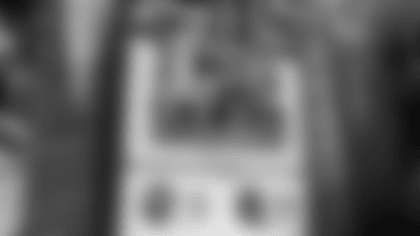EAST RUTHERFORD, N.J. - The NFL's much-publicized effort to make football a safer game has resulted in condemnation from some fans and even players who contend too much of the mayhem and toughness have been removed from the league.
John Mara vehemently disagrees.
"I think most people feel like the game has never been better," Mara said. "You do read some criticism out there from certain quarters that the game is not as tough as it used to be, because we are restricting so many of these hits. I just don't think that at all. And I have said this many times. If you were to stand on the sideline and watch a game, or even watch a scrimmage, you can't tell me the game is any less physical."
Mara knows of what he speaks. He is not only the Giants' President and Chief Executive Officer, but a 13-year member of the NFL's influential Competition Committee, which studies all aspects of the game and recommends rules and policy changes to NFL clubs.
Aside from Mara, the committee members are Chairman Rich McKay (the Atlanta Falcons' President), as well as coaches Jeff Fisher of St. Louis and Marvin Lewis of Cincinnati, general managers Rick Smith of Houston and Ozzie Newsome of Baltimore, and executives Stephen Jones of Dallas and Mark Murphy of Green Bay.
Mara disputes the notion that Roger Goodell's emphasis on player safety has forced the committee to spend more of its time and discussion on that topic.
"I think it is certainly an issue that has gotten more public attention," Mara said. "But I don't think it is any more important to us than when I started in 2001. The first meeting I was in, (former Giants general manager) George Young was in the league office and he was a liaison to the committee, and player safety was the most important priority then, and it remains that today. I think certainly it has gotten more attention recently, but I don't think our emphasis has changed at all."
The committee meets annually in February at the NFL Scouting Combine and again in March, just prior to the league's annual meeting. This year, it presented three rules proposals that addressed player safety and were overwhelmingly approved by the league's owners.
The first prohibits offensive or defensive players from initiating contact with the top/crown of the helmet when they are clearly outside the tackle box.
"There were too many incidents when it appears like the offensive or defensive player is using the helmet as a weapon," Mara said. "And it is a particularly dangerous play. What influenced me quite a bit was sitting in Indianapolis next to a couple of our doctors with the Head, Neck and Spine Committee, watching tape of some of these plays and having them remark how dangerous this tactic is and how great it would be if we could try to get it out of the game. One of the biggest misconceptions about this is you hear it described as a penalty against the running back. But it also applies to the defender that lowers his head to strike a force of a blow and initiate contact with his helmet."
Mara said the support of the measure is indicative of the growing awareness regarding player safety.
"We started out with probably about 10 teams that seemed like they were against it, mostly because of comments from coaches," Mara said. "The coaches were concerned about how the foul was going to be called – their concern was whether it was going to affect the outcome of the game. They gradually relented. I think people realize that there are certain plays that we have to try and take out of the game if we can."
The proposed rule passed 31-1, with only the Cincinnati Bengals voting against it.
"The common theme was to take the head out of the game and put the shoulder back into it," Mara said. "That is something that came from a number of coaches.
"The interesting aspect of this rule is that because we are a little concerned about how it is going to be called at first, the officials are only going to call it if they are absolutely certain. Right now, the hits on defenseless receivers that you see in the secondary, the officials are told to err on the side of player safety. If it appears to be helmet-to-helmet contact, or contact to the player's head or neck area, throw the flag. That is not going to be the case here. We want them to throw it only if it looks to be a clear situation where they have initiated contact with the crown of the helmet."
Mara disagrees with those, including players, fans and coaches, who say the owners have removed too much of the physical play from the NFL.
"We are just trying to take certain dangerous aspects out of it," he said. "You can't legislate every dangerous play out of the game, because it is a tough sport. There is certainly always going to be a risk of injury. But there are certain hits that we feel are unnecessary and not something that we want in the game. And that is where our focus has been. We are very influenced in those situations – at least I am – by what the coaches have to say. They are the ones that teach the technique. And they are the ones that can tell us that certain techniques are necessary and certain techniques are not and are dangerous and have no place in the game. We have two excellent coaches in Marvin Lewis and Jeff Fisher, both of whom historically have coached very physical, hard-hitting teams. But they understand the importance of trying to make the game safer going forward and trying to protect players as much as possible.
"Also the colleges, high school and youth football leagues always look to the NFL for guidance on these things. We just want to change the culture, to get players to stop dropping their heads – to keep their heads up. For years and years we used to see signs in lockers rooms that said, 'See what you hit.' There would be diagrams of the player making a tackle with his head up. All of the coaches have said that is always the way they have taught players how to do it. This phenomenon of players dropping their heads and using their helmets like weapons has to stop."
A second new rule will provide more protection to the snapper and other offensive linemen during a field goal or extra point attempt. In both 2009 and 2010 the league enacted rules to help protect snappers, but his year went a step further.
"This was motivated primarily by two different sources," Mara said. "One, Tom Coughlin presented us with a tape which showed not only the snapper but other players on the offensive line just getting blown up by the other team that is stacking numerous players over your head, or coming in low. In addition to that, we meet with the players every February to get their input on changes. (Center) Will Montgomery of the Redskins came in with a similar tape, asking us to please consider more protection for the snapper and for people on the line during extra points and field goal attempts.
"The tape was pretty compelling. People were really getting beaten up there. Coaches said it is hard to get players to play in those situations, because sometimes defensive players just look at it as an opportunity to take a free shot. As a result of that there are restrictions on how you can line up. You are not going to have those pushers any more behind the line. And there has to be a certain amount of players on each side of the center."
The third player safety rule concerned the "peel back" block. Previously, if a lineman peeled back in the tackle box and hit the defensive player low it was not a penalty. The committee recommended and the owners voted to make it a penalty.
"You can't hit him below the waist in the tackle box," Mara said. "That doesn't apply to inline plays where you will see some low blocks, but it has to do with what is defined as the 'peel back' where he starts outside and comes back in.
"The big play was the (Brian) Cushing play against the Jets (when the Houston linebacker suffered a season-ending knee injury). That ended up outside of the tackle box but it was very close to being inside the tackle box, which would have been legal. And I think everybody's opinion was that that should never be held up, no matter where it occurs. Often times what happens is there is a signature play - sometimes it is more than one play - that causes you to focus attention on it. That happened to be the play this time even though the officiating department said it was an illegal block. But it was so close to being within the tackle box we wanted to make sure that that block came out of there."
Mara shared his thoughts on several other topics discussed by the Competition Committee:
*"We had a discussion on whether to do anything on kickoffs (which were moved up five yards to the 30-yard line in 2011)," Mara said. "We ultimately decided that we think we have the best of both worlds right now. We have significantly reduced the number of injuries, including the number of concussions on kickoffs. But it still remains an exciting part of the game; witness the Super Bowl (where Baltimore's Jacoby Jones returned a kickoff 108 yards for a touchdown). Guys are now bringing the ball out from eight or nine yards deep in the end zone. It remains an important part of the game. We have reduced the number of returns, but that has led to a big reduction in the number of injuries."
*Players will now be required to wear knee and thigh pads during games.
"Prior to the game, league office uniform inspectors will conduct random checks on players," Mara said. "And that can take place either in the locker room or on the field or in any area in the stadium. Once the game starts those uniform inspectors will have access to the sideline. They will have the ability to notify an official if a player does not have the proper pads on. That player will be removed from game.
"(The players) are not crazy about this rule. They seem to think that thigh and knee pads are not going to protect them from injury. But after talking with the medical people we believe it is common sense that extra padding on your body is going to reduce the impact of certain blows."
*One of the fears about weekly Thursday night games did not materialize.
"There was some concern expressed last year that the increase in the Thursday night games would lead to an increase in injuries," Mara said. "But the statistics did not show that at all, which was, quite frankly, a surprise to me. But according to the numbers that we had, the injury rate for Thursday games was 5.2 per game and in games on Saturday, Sunday and Monday the rate was 5.3 a game. Thursday night games have become standard now, so that was a comforting statistic."
*Twelve teams have comprised the postseason field each season since 1990. Mara has favored keeping that number, but said sentiment is growing to expand it.
"We did have some discussion about expanding the playoffs," Mara said. "Most of that discussion was if you were to do it, how could you do it and make it competitively fair, or what would be the best way to do it. I would say there is probably more support for expanding the playoffs now than there ever has been. I don't know if there is enough to pass yet, because like anything else, you need three-quarters vote (24 of the 32 teams). My opinion continues to be that I like the system that we have now. It means something. It is an achievement to make the playoffs. And I don't want to dilute it. But it does seem like it is starting to gain a little bit more momentum. I wouldn't be shocked if at some point over the next few years that we go to 14 teams in the playoffs."
That would not, however, add an additional week to the postseason.
"I think what it would probably do is just reduce the byes to one team in each conference," Mara said. "That was one of the things that we discussed. If you did it with 14, how would you work it? Would you want to have a play-in game? Would you just want to give the number one seed the bye? I think the consensus was just to give the number one seed a bye. I don't think too many people are interested in going one step further to make it a 16-team playoff."
MORE FROM GIANTS.COM
|






